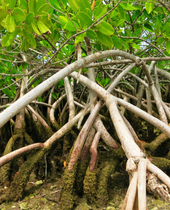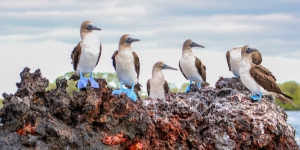Of all the challenging places that trees survive, there may be none more unfriendly than the ocean coasts. Any plants that brave this region must contend with battering wind and waves, ever-changing tides, immersion in saltwater, and a root system choked by water-logged mud. It is nearly impossible for trees to live there, so few do.
For mangroves, though, these coastal conditions are simply a challenge to overcome. There are around 100 tree species we call mangroves, and they live on ocean coasts and river estuaries throughout the world’s tropical and subtropical regions. They are not all related to each other – the term ‘mangrove’ refers not to a family of trees, but to trees from several families that have evolved to meet the unique demands of this habitat.
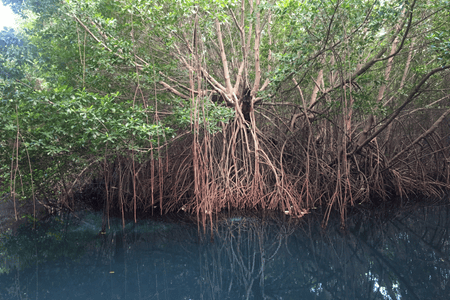
A view of Red Mangrove (Rhizophora mangle), the best-known mangrove species (in Jamaica, © Chris Earley)
Mangrove survival begins with roots. Extensive root systems anchor them in loose, shifting substrates. The roots often extend well above the soil, propping the trees above the highest tides. When the waves recede, these aerial roots can take up gases that are not available when submerged.
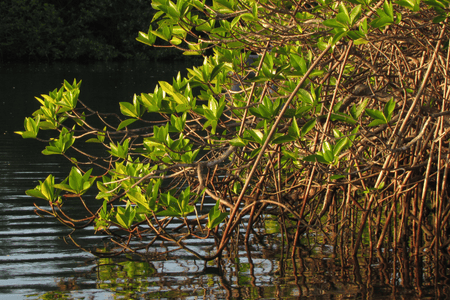
Red Mangrove stands expand as the trees drop prop roots into the water and mud below from the outer branches. Later these thicken. (© Ian Shanahan, Galapagos)
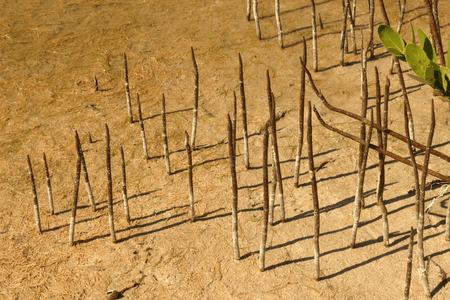
Rather than drop roots into water like some other mangroves, the Black Mangrove (Avicennia germinans) end up pneumatophores (© Katja Schultz, Yucatán, Mexico)
Roots also take up water, and here the mangroves must surmount another obstacle. The water they live in is saline, and they must remove the salt before they can use it. Some species do this using complex filtering systems to exclude salt right at the root. Others take up the salt with the water, but excrete it through their leaves. Others simply store the salt in their tissues.
Their varied survival strategies mean that each mangrove has unique tolerances, and survives only where conditions are just right. For this reason, the number of mangrove species in a given area is often low. In the neotropics, where tree diversity is at its highest, a mangrove forest may comprise as few as three species. These species often segregate themselves according to conditions with little overlap, forming uniform stands of each.
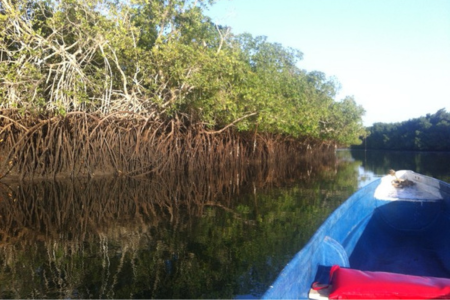
The Red Mangrove tolerates the large amplitudes of tides, represented here by the dark brown band of roots standing above the water here but below the leaf line. As such it is often at the “leading edge” of colonization. (© Justin Peter, the Gambia)
To me, this begs an obvious question. If mangrove forests are just a few hardy tree species eking out an existence in a difficult place, why do they generate so much interest? Why do we visit them on our tropical tours, and why are they the focus of so many conservation programs?
Mangrove trees are more than stubborn survivors; they are architects of their environments. Submerged mangrove roots provide a welcoming, sheltered habitat for all kinds of marine animals. They are a refuge for small fish, and an anchoring place for creatures like molluscs and sponges.
Mangrove trees are more than stubborn survivors; they are architects of their environments. Submerged mangrove roots provide a welcoming, sheltered habitat for all kinds of marine animals. They are a refuge for small fish, and an anchoring place for creatures like molluscs and sponges.
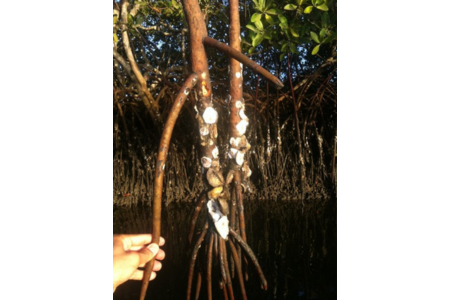
They also trap mud and sediment, attracting bottom-dwellers like crustaceans. As mangrove leaves fall, they are eaten and broken down by many of these very animals.
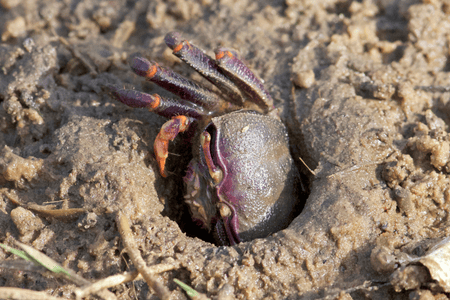
A fiddler crab (Afruca tangeri ) living in the mud below sheltering mangroves emerges at low tide. It will feed on detritus falling from the mangroves above. (© Justin Peter, The Gambia)
They add nutrients to the soil, fostering a community of microorganisms on which to build food chain. That food chain extends all the way up out of the water, as the abundance of aquatic creatures attracts birds like kingfishers, herons, and raptors, along with a variety of mammals and reptiles.
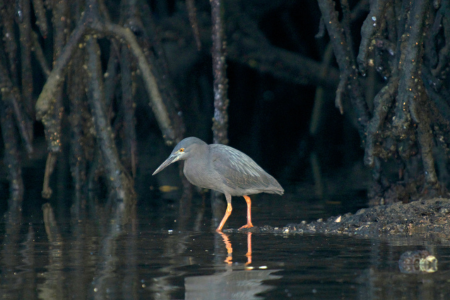
A Lava Heron stalks small fish in the shelter of a mangrove stand. (© Justin Peter, the Galapagos)
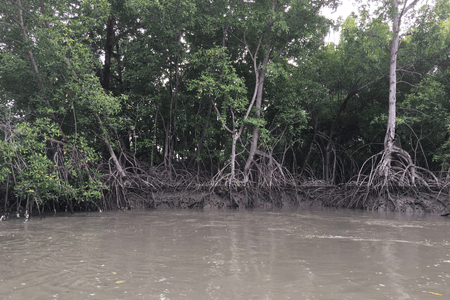

A Lava Heron stalks small fish in the shelter of a mangrove stand. (© Justin Peter, the Galapagos)
Mangroves have a broader impact, too. They stabilize shorelines with their extensive root systems, guarding against erosion.

This established mangrove stand successfully buffering a shoreline against tidal swell. (© Justin Peter, The Gambia)
This is especially critical during extreme weather. Mangrove forests can protect coastal habitats and communities from events like hurricanes and tsunamis, and harbour a source of food and income for those who live there.
Mangrove forests are also adept at storing carbon. The trees capture atmospheric carbon and deposit it in their tissues. When the leaves fall or the tree dies, they decompose and release their carbon into the soil. That soil remains trapped by the forest’s root network, sequestered out of the atmosphere. In this way, the maintenance and restoration of mangroves could play a critical role in fighting climate change.
A mangrove forest can appear uniform, stark, or even a little alien, but the trees that comprise it are performing a task that few others can. They are transforming one of the Earth’s harshest environments into a healthy, stable habitat for all manner of creatures, including humans. We owe them a great deal, and they are well worth a visit the next time you find yourself on a tropical seashore.
A mangrove forest can appear uniform, stark, or even a little alien, but the trees that comprise it are performing a task that few others can. They are transforming one of the Earth’s harshest environments into a healthy, stable habitat for all manner of creatures, including humans. We owe them a great deal, and they are well worth a visit the next time you find yourself on a tropical seashore.
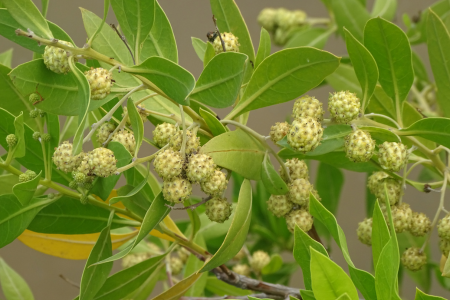
Mangroves represent a wide range of trees and shrubs, many unrelated, performing a similar ecological function but presenting a diversity of appearances. The Button Mangrove (Conocarpus erectus) has these distinctive “button” fruit. (© Josh Vandermeulen, Galapagos)
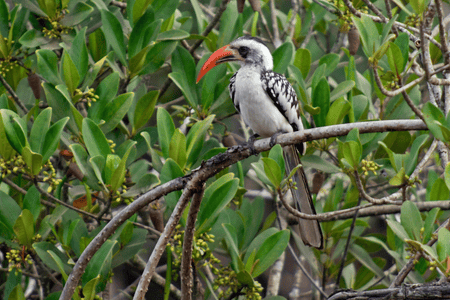
A Red-billed Hornbill gracing a mangrove prop root near a coastline (© Justin Peter, The Gambia)
We can see mangroves on a large number of our Quest Nature Tours departures, including to Trinidad & Tobago, Costa Rica, The Gambia, the Dominican Republic, the Galapagos, and the Yucatan Peninsula in Mexico.


